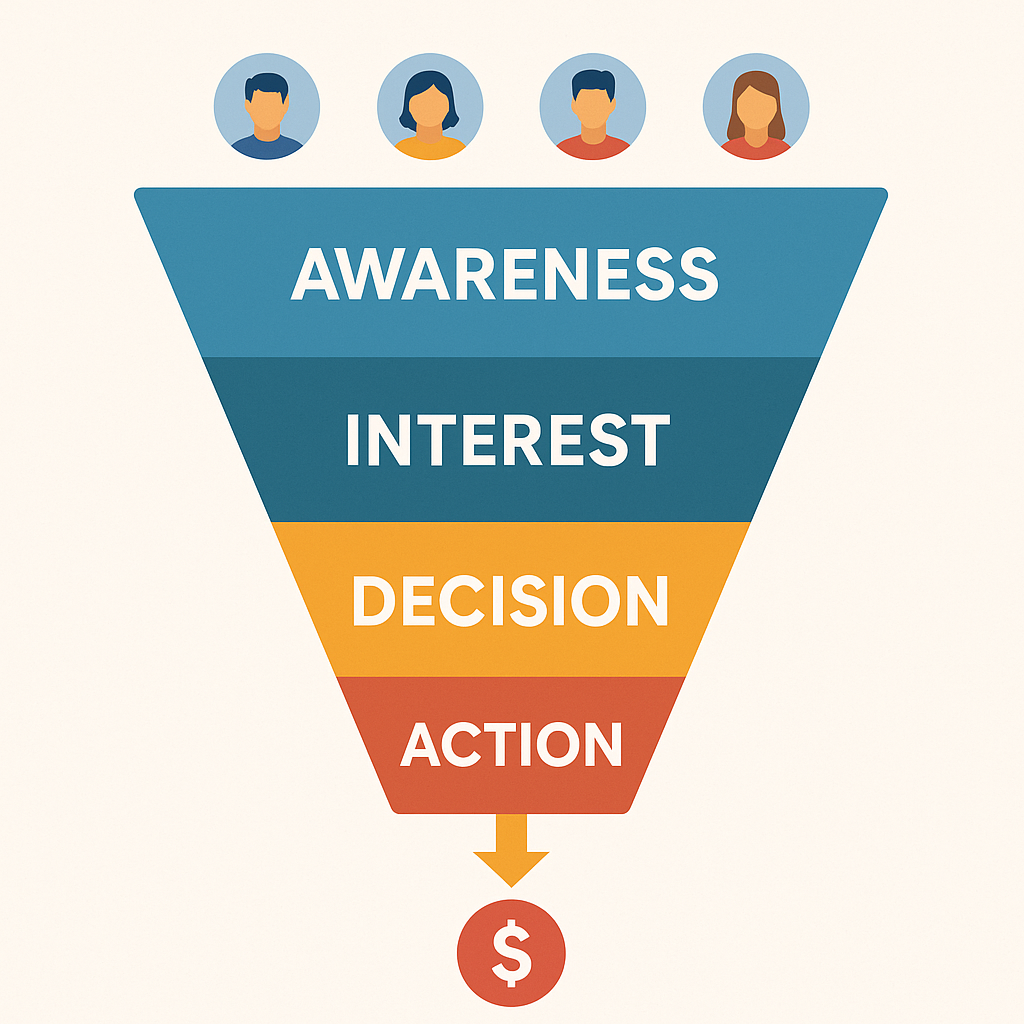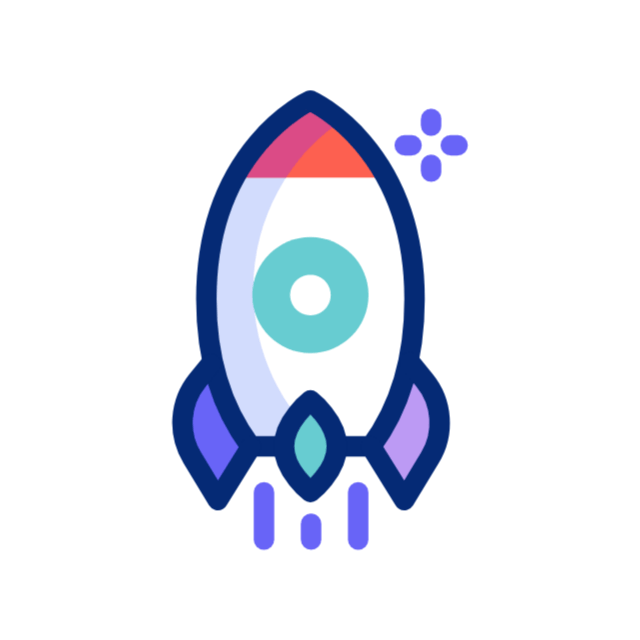
Everything You Need to Know About the Path to Conversion
In the world of digital marketing, understanding customer behavior is the key to generating sales and growing your business. One of the most powerful concepts that marketers and businesses use to track, manage, and increase sales is the Sales Funnel.
A sales funnel is more than just a fancy term; it’s a step-by-step model that shows how a potential customer goes from being a stranger to becoming a paying customer—and potentially a loyal brand advocate. In this blog, we will explore what a sales funnel is, how it works, why it’s important, and how to create one that actually converts.
Table of Contents
- What is a Sales Funnel?
- Why is the Sales Funnel Important?
- Stages of a Sales Funnel
- Real-World Example of a Sales Funnel
- How to Build a Sales Funnel
- Tips to Optimize Your Sales Funnel
- Final Thoughts
1. What is a Sales Funnel?
A Sales Funnel is a visual representation of the journey a customer takes from the first interaction with your brand to the final purchase. It’s called a “funnel” because many people enter the top of the funnel (awareness), but only a smaller number make it to the bottom (conversion or sale).
Each stage of the funnel is designed to move the customer one step closer to purchasing. The idea is to nurture leads by giving them the right content, information, or offer at the right time.
2. Why is the Sales Funnel Important?
Understanding and using a sales funnel is crucial for several reasons:
- Customer Journey Tracking: It helps businesses understand how potential customers behave.
- Improved Conversion Rates: By addressing every stage of the funnel, you guide customers more efficiently to make a purchase.
- Better Marketing Strategy: You can create more targeted and effective marketing campaigns for each stage.
- Efficient Sales Process: A structured funnel streamlines your sales strategy, saving time and resources.
- Forecasting Sales: Funnels allow businesses to estimate how many leads will likely convert into customers.
3. Stages of a Sales Funnel
A traditional sales funnel has four major stages:
a. Awareness (Top of Funnel – TOFU)
This is where a potential customer first learns about your business. They may find you through social media, blogs, ads, SEO, or word of mouth. The goal here is to create brand awareness.
Marketing strategies for this stage:
- Blog posts
- Social media content
- Paid advertisements
- SEO optimization
- Free webinars
b. Interest (Middle of Funnel – MOFU)
At this stage, the potential customer shows interest in your products or services. They may start to engage with your content, sign up for newsletters, or follow you on social media.
Marketing strategies for this stage:
- Email newsletters
- Case studies
- Downloadable guides or eBooks
- Informational videos
- Product comparisons
c. Decision (Middle/Bottom of Funnel)
The customer is now considering buying. They compare products, read reviews, and analyze whether your offer meets their needs.
Marketing strategies for this stage:
- Free trials or demos
- Customer testimonials
- Limited-time discounts
- Live chats or consultations
- Retargeting ads
d. Action (Bottom of Funnel – BOFU)
This is the final stage, where the prospect becomes a customer. They complete a purchase, sign up for a service, or take the desired action.
Marketing strategies for this stage:
- Clear CTAs (Call-to-Actions)
- Secure, fast checkout process
- Follow-up emails confirming purchase
- Post-sale support or onboarding
4. Real-World Example of a Sales Funnel
Let’s say you run a web design agency like WebMarkitors.
- Awareness: A small business owner finds your Instagram reel offering website design for ₹10,000.
- Interest: They visit your website, read your blog, and sign up for your free guide on “10 Website Mistakes to Avoid”.
- Decision: They compare your service with other agencies and check reviews on your Instagram and Google profile.
- Action: They schedule a free consultation and decide to buy your web design package.
After the sale, you can even add a loyalty or advocacy phase by offering additional services or asking for referrals.
5. How to Build a Sales Funnel
Creating an effective sales funnel takes planning and testing. Here’s a step-by-step guide:
Step 1: Understand Your Target Audience
- Who are your ideal customers?
- What problems are they trying to solve?
- Where do they spend time online?
Step 2: Create Awareness
- Use content marketing, SEO, paid ads, and social media to reach your audience.
- Offer free resources like blogs, eBooks, or checklists.
Step 3: Capture Leads
- Use lead magnets (like free downloads or webinars) in exchange for their email address.
- Add opt-in forms on your website and landing pages.
Step 4: Nurture the Relationship
- Send personalized email sequences.
- Educate your leads with helpful content.
- Engage with them on social media.
Step 5: Convert Leads into Customers
- Offer time-sensitive discounts or one-on-one calls.
- Provide social proof, such as testimonials or case studies.
- Make the purchase process smooth and simple.
Step 6: Retain and Upsell
- Send thank-you emails and offer additional services.
- Use follow-up emails to gather feedback.
- Offer loyalty programs or referral bonuses.
6. Tips to Optimize Your Sales Funnel
To make your sales funnel more efficient, consider these tips:
✅ Use A/B Testing
Test different headlines, CTAs, images, and layouts to find what converts best.
✅ Track Funnel Metrics
Key metrics include:
- Conversion rate
- Bounce rate
- Cost per lead (CPL)
- Customer acquisition cost (CAC)
✅ Segment Your Audience
Send different messages to new leads, warm leads, and existing customers.
✅ Use Automation
Use tools like Mailchimp, HubSpot, or ActiveCampaign to automate emails, lead scoring, and CRM tasks.
✅ Remove Friction Points
Make sure your website is fast, mobile-friendly, and easy to navigate. Confusion kills conversions.
7. Final Thoughts
A sales funnel is not just a marketing model—it’s a roadmap to customer conversion. Whether you’re selling digital courses, website design services, or any other product, understanding how a user goes from discovery to purchase can transform your business.
Every stage in the funnel deserves attention. The better you guide your prospects, the more likely they are to become not just customers—but loyal fans who recommend your brand to others.
Key Takeaway:
If you’re running a business like WebMarkitors, creating a strong sales funnel can help you:
- Attract more leads
- Build trust
- Increase conversions
- Boost long-term revenue
So, start mapping your sales funnel today, and turn your digital audience into paying customers!
Let me know if you’d like this blog formatted for your website, or if you want a matching graphic/post for social media.

